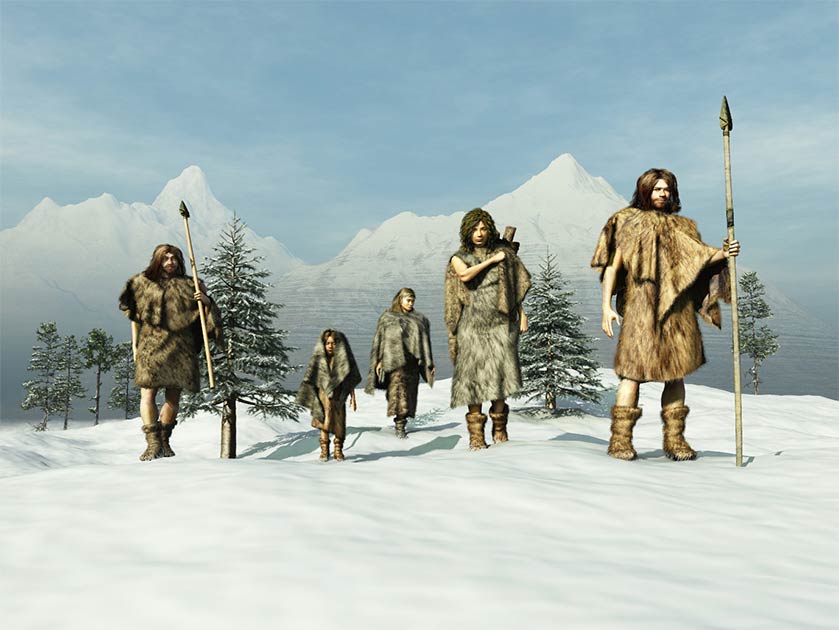New Evidence Reveals Ice Age Hunters Didn’t Migrate South In Winter
Winter in Ice Age Europe was not for the faint-hearted. There has been a long-running debate between experts as to whether humans migrated out of Northern Europe during the savage winters, or did they brave the extreme cold. Recent discoveries at a very important Paleolithic site in Poland appear to show that Ice Age hunters were active on the North European Plain in the depths of winter throughout the Ice Age! This is an extraordinary new understanding of Ice Age hunters in the one season, when we assumed they migrated south to warmer lands.
Archaeologists from Exeter University, England have been investigating animal remains from the Paleolithic Krakow Spadzista site in Poland, which led to a new understanding of Ice Age hunters. According the Exeter University press release, this “was one of the most northerly sites in central Europe during the Late Gravettian, when much of the northern plains region had already been abandoned. Mean annual temperature was between -1.0 °C and +4.3 °C.” The Late Gravettian was a Paleolithic culture, whose artifacts have been found throughout northern Europe.
How Arctic Fox Teeth Told A Different Story
Researchers wrote in the Journal of Archaeology that the site “is important for understanding human behavior and adaptation in cold, northern and marginal landscapes approaching the coldest part of the last glacial cycle.” Their work focuses on the thousands of bones of Arctic foxes unearthed at the site. The researchers stated it “presents new data on the mobility patterns and season of death of the animals killed by Gravettian hunters.” The remains are approximately 27,500 years old and were found some 20 miles (30 km) south of an assemblage of mammoth bones, that had presumably also been killed by hunters.

An Artic fox on the hunt in winter resistant to the super cold, just like the Ice Age hunters (Olha / Adobe Stock)
The team focused on the teeth of the foxes and tested their isotopes to determine where they had been born and where died. Researchers wrote in the Journal of Archaeology that “Laser ablation strontium isotope analysis of teeth from five individuals indicates that each analyzed fox was born and grew up in a different and isotopically distinct location.” This means these foxes had travelled hundreds of miles looking for prey, and eventually went as far south as Krakow Spadzista, a little north of the border of Slovakia.
Ice Age Winter Hunting: For Furs And Fox Fat
The University of Exeter reports that “Analysis of the dental cementum of at least 10 fox individuals demonstrate that the majority were killed between late winter and late spring, most likely in late winter.” The remains indicated that the foxes were various ages when they died. “The study suggests the Arctic fox colonized the area because they moved over long distances season by season, something they still do today, in order to find food,” according to the press release. It appears that they were killed by hunters using snares and traps.
Dr Alexander Pryor of the University of Exeter stated that the “Arctic fox provided both food and hides to Paleolithic hunters.” They would have sought to kill them in the depths of winter because that was when their fur was at its longest and thickest. Moreover, their body was fat during this season and could, therefore, provide protein to the hunters, which they needed in the extreme cold.

An Artic fox with its front paw caught in a hunter’s trap (Nationalmuseet - National Museum of Denmark from Denmark / CC BY-SA 2.0)
Base camp for hunters
“The high numbers of fox remains found at the site suggests what was happening was a deliberate, organized procurement strategy rather than just simple incidental hunting,” said Dr Pryor in an article in the Heritage Daily. There was no evidence of long-term dwelling at the site, strongly suggesting that the Krakow Spadzista settlement was not used year-round.
The animal teeth analysis has clearly shown that Ice Age hunters snared and trapped migrating Arctic foxes in the coldest months of the year. Based on this insight, the site at Krakow Spadzista was likely used as a base camp by Paleolithic hunters. The prehistoric humans would use it to maintain traps and also to skin and butcher the foxes that they had trapped. Essentially, Krakow Spadzista was used as a location to process the hides of the animals, which were then taken elsewhere.
This study provides evidence that “communities living around 27,500 years ago were killing small prey in the inhospitable North European Plains during the winter months of the last Ice Age.” This seems to support the argument that early humans did not migrate from cold regions during the Ice Age. Rather they stayed even during the intense cold and extreme weather of the winter. Most of the foxes were killed during between the late winter and early spring, based on the analysis data.
- Stone Age people were eating porridge 32,000 years ago
- 28,000-Year-Old Mammoth Kill Site Discovered in Austria
- Archaeologists Identify First Prehistoric Figurative Cave Art in Balkans - It’s Symbolic!
In the Journal of Archaeology, the team wrote that “The results are interesting for reconstructing the context to human hunting strategies in the Late Gravettian.” It seems likely that the availability of Arctic foxes and other animals, such as mammoths, persuaded them to stay and endure the cold as these very animals provided them with furs and nourishment. The latest discoveries demonstrate the resourcefulness and adaptability of the prehistoric communities who lived in northernly and marginal lands during the last Ice Age. Moreover, it proves that northern Europe was not deserted by people during the extended period of extra cold weather.
Top image: Ice Age hunters endured the harsh climate in Northern Europe. Source: anibal / Adobe Stock
By Ed Whelan



















